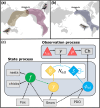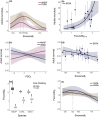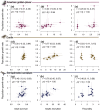Evaluating environmental drivers and synchrony of Arctic shorebird demographic rates to inform conservation management
- PMID: 40545669
- PMCID: PMC12183352
- DOI: 10.1002/eap.70049
Evaluating environmental drivers and synchrony of Arctic shorebird demographic rates to inform conservation management
Abstract
Many Arctic-breeding shorebirds are assumed to be declining, yet obtaining reliable estimates of species' demographic rates and trends is difficult because of challenges collecting data in remote breeding regions and throughout the annual cycle. For many vulnerable species, data limitations impede efforts to determine appropriate management actions in the face of ongoing environmental change. Integrated population models (IPMs) offer an approach to maximize the utility of available data by providing a framework for estimating demographic rates and environmental drivers of population change, while also accounting for sources of uncertainty. Here, we used an IPM to estimate demographic rates, synchrony, and population trends of Arctic-breeding shorebirds within the context of climatic and management-related changes. We estimated species-specific breeding population sizes, adult survival rates, number of adults gained into the breeding population through recruitment (i.e., the sum of immigration and reproduction), as well as the effects of environmental drivers on demographic traits for three shorebird species nesting near Utqiaġvik, Alaska, over an 18-year study period (2005-2022). We found that the annual number of adults recruiting into the breeding population was important for maintaining local populations, and that local environmental factors and management regimes had strong effects on demographic rates. The timing of snowmelt had a notable effect on (1) fecundity, (2) the number of adults recruited for two of the three species, and (3) adult survival during the following year for one species. Predator removal increased fecundity of all three species but had limited effects on subsequent local population sizes. The Pacific Decadal Oscillation, a broad-scale climate metric, affected adult survival differently across species, with a positive and negative effect for one species each, and a negligible effect for the other. Unlike adult recruitment and fecundity that varied synchronously among species, annual adult survival varied asynchronously. Our results suggest that differences in survival were likely related to conditions experienced during nonbreeding periods arising from dissimilar migratory routes, stopover sites, and nonbreeding season ranges. Future work should focus on incorporating additional environmental factors on the nonbreeding grounds to determine when and where these species could benefit most from management interventions.
Keywords: Arctic‐breeding shorebirds; demographic rate synchrony; integrated population model; nonbreeding season.
© 2025 The Author(s). Ecological Applications published by Wiley Periodicals LLC on behalf of The Ecological Society of America.
Conflict of interest statement
The authors have no conflicts of interest to disclose, and all authors have approved this work for publication. We certify that the submission is original work and is not under review at any other publication. The findings and conclusions in this article are those of the author(s) and do not necessarily represent the views of the US Fish and Wildlife Service.
Figures





Similar articles
-
Environmental drivers of productivity explain population patterns of an Arctic-nesting bird across a half-century.Ecol Appl. 2025 Jul;35(5):e70067. doi: 10.1002/eap.70067. Ecol Appl. 2025. PMID: 40611677 Free PMC article.
-
A rapid and systematic review of the clinical effectiveness and cost-effectiveness of paclitaxel, docetaxel, gemcitabine and vinorelbine in non-small-cell lung cancer.Health Technol Assess. 2001;5(32):1-195. doi: 10.3310/hta5320. Health Technol Assess. 2001. PMID: 12065068
-
Home treatment for mental health problems: a systematic review.Health Technol Assess. 2001;5(15):1-139. doi: 10.3310/hta5150. Health Technol Assess. 2001. PMID: 11532236
-
Signs and symptoms to determine if a patient presenting in primary care or hospital outpatient settings has COVID-19.Cochrane Database Syst Rev. 2022 May 20;5(5):CD013665. doi: 10.1002/14651858.CD013665.pub3. Cochrane Database Syst Rev. 2022. PMID: 35593186 Free PMC article.
-
Cost-effectiveness of using prognostic information to select women with breast cancer for adjuvant systemic therapy.Health Technol Assess. 2006 Sep;10(34):iii-iv, ix-xi, 1-204. doi: 10.3310/hta10340. Health Technol Assess. 2006. PMID: 16959170
References
-
- Alaska Shorebird Group . 2019. Alaska Shorebird Conservation Plan. Version III. Anchorage, AK: Alaska Shorebird Group.
-
- Alerstam, T. , and Lindström Å.. 1990. “Optimal Bird Migration: The Relative Importance of Time, Energy, and Safety.” In Bird Migration, edited by Gwinner E., 331–351. Berlin, Heidelberg: Springer.
-
- Andres, B. , Moore L., Cox A., Frei B., and Roy C.. 2022. “A Preliminary Assessment of Shorebird Harvest in Coastal Guyana.” Wader Study 129: 39–47.
-
- Atlantic Flyway Shorebird Initiative (AFSI) . 2020. “Actions for the Atlantic Flyway Shorebird Initiative's Shorebird Harvest Working Group 2020–2025.” https://www.shorebirdplan.org/wp-content/uploads/2020/09/AFSI-Shorebird-....
MeSH terms
Grants and funding
- F17AC00575/US Fish and Wildlife Service
- Arctic Landscape Conservation Cooperative
- U.S. Fish and Wildlife Service (Alaska Region, Migratory Bird Management Division
- Alaska Region and National Avian Health and Disease Programs)
- U.S. Geological Survey, National Fish and Wildlife Foundation, Neotropical Migratory Bird Conservation Act
LinkOut - more resources
Full Text Sources

